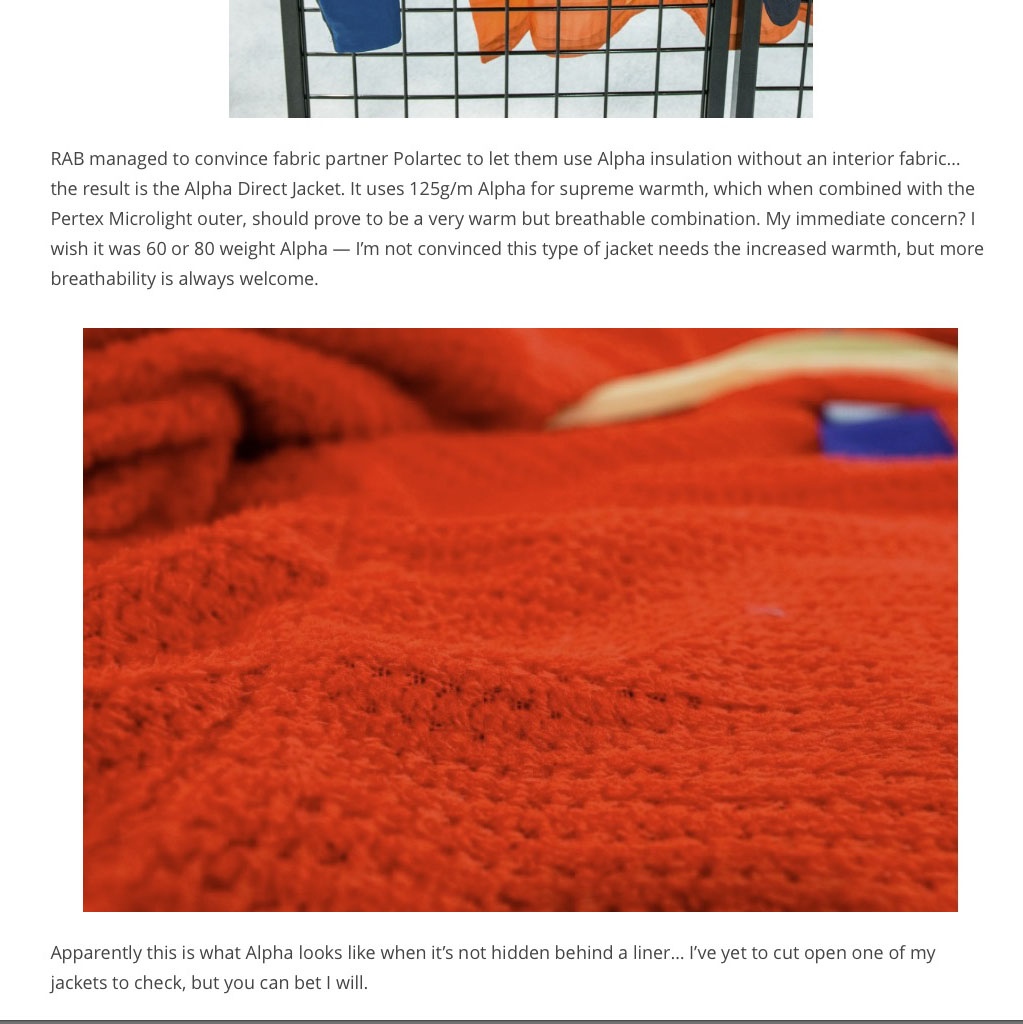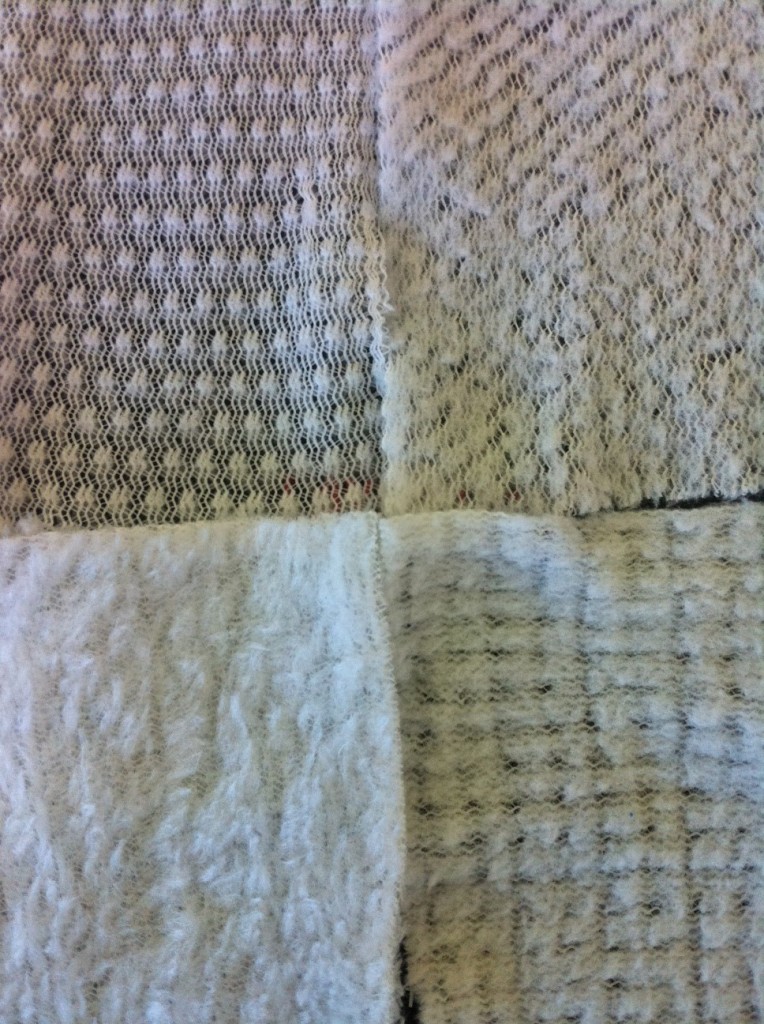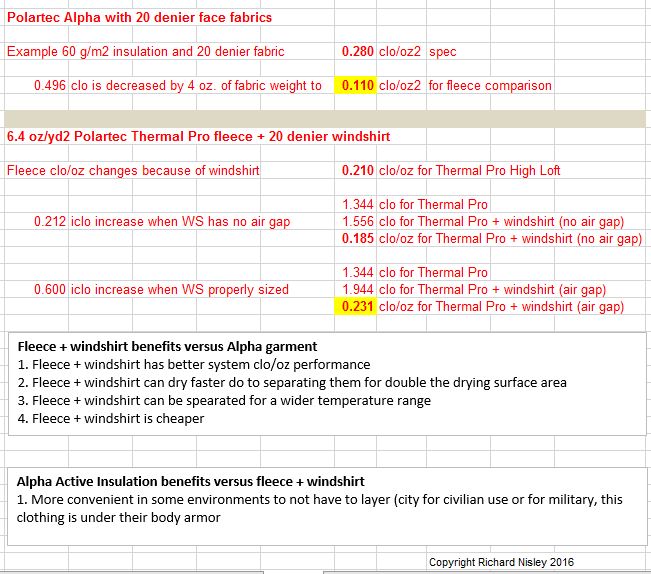Topic
Polartec Alpha?
Forum Posting
A Membership is required to post in the forums. Login or become a member to post in the member forums!
Home › Forums › Gear Forums › Gear (General) › Polartec Alpha?
- This topic has 131 replies, 10 voices, and was last updated 3 years, 5 months ago by
 Michael E.
Michael E.
-
AuthorPosts
-
Oct 12, 2016 at 3:04 am #3430708
Last winter I had the impression there was a lot of buzz around Polartec Alpha, because it was described as a good compromise of insulation/breathability for below freezing conditions. Just last night I was looking at the Rab catalogue (Rab used to offer at least 2 if not 3 jackets with PA). Nothing. Googling Polartec Alpha jacket does not give much (nothing really) being sold as current for winter 2016. What happened?
Oct 12, 2016 at 4:39 am #3430713Oct 12, 2016 at 6:25 am #3430715Oct 17, 2016 at 4:29 am #3431514So, what is Alpha exactly?
I mean I read it was based on Thermal Pro Hi-Loft Fleece, this photo of the inner of the Rab Alpha Direct looks more (thermal pro high loft) fleece like than I expected. Curious what changes were made to it and in what way the two differ.
 Oct 17, 2016 at 11:20 am #3431549
Oct 17, 2016 at 11:20 am #3431549It looks like the gridded version of thermal pro that I have seen on some jackets.
So basically a thermal pro jacket combined with an air permeable windshirt is functionally the same thing as a polartec alpha jacket but 2 layers instead of one.
Oct 17, 2016 at 2:43 pm #3431579Justin,
Yes it is the equivalent; most of the “active wear” jackets have the equivalent of both an outer and an inner windshirt with unspecified CFMs.
Oct 17, 2016 at 3:42 pm #3431587That picture of the liner looks different from this one from Hiking In Finland. Maybe it’s my eyes.
 Oct 17, 2016 at 4:13 pm #3431593
Oct 17, 2016 at 4:13 pm #3431593Justin wrote
It looks like the gridded version of thermal pro that I have seen on some jackets.
So basically a thermal pro jacket combined with an air permeable windshirt is functionally the same thing as a polartec alpha jacket but 2 layers instead of one.
Yeah, exactly. Though in the case of the Rab Alpha Direct one wind shirt on the outside (no liner).
Oct 17, 2016 at 4:39 pm #3431594Nisley wrote:
Yes it is the equivalent; most of the “active wear” jackets have the equivalent of both an outer and an inner windshirt with unspecified CFMs.
So in the case of the Rab Alpha Direct (photo above) the outer liner is Pertex Equilibrium. With a pretty high CFM (10 off the top of my head), but at least in my experience with the material, also not the strongest most long lasting fabric.
If you say it is equivalent, and to me it certainly looks that way, I was wondering if you happen to know what is different between the Alpha and a gridded version of Thermal Pro Hi Loft – if anything? Excluding the liner that is.
Oct 17, 2016 at 5:22 pm #3431605Here is an old picture of 60g, 80g, 100g, and 120g Polartec Alpha, going clockwise, from Ice Climbing Japan:
 Oct 17, 2016 at 5:29 pm #3431608
Oct 17, 2016 at 5:29 pm #3431608Nice one Christopher, I read their blog but hadn’t seen that before.
The heavier weights look more similar than the lower weights but even then it doesn’t look as similar as the photo of the Rab above.
I think it could be interesting perhaps to have Thermal Pro Hi Loft available in lower weights, like they do with the Power Dry.
`
Oct 19, 2016 at 1:36 am #3431857Alpha is showing up in several companies, just not as prominent as some other types of insulation (looking at you primaloft). Rab uses it as others have mentioned, but also Mammut, Outdoor Research (their Uberlayer is pretty fantastic), and Dynafit (EU brand, but really solid stuff). Also Patagonia has their Nano-Air stuff that is similar.
These are just what I own/have used now or in the past year. Marmot uses it for some stuff, and I hear Arc’teryx has something similar. If you get it though, be choosy with the face and liner fabrics. If they don’t breathe well, you are limiting the potential of Alpha.
Oct 20, 2016 at 2:58 pm #3432096Recently I’ve been walking in the rain with just a fleece pullover (no base layer to get wet and clammy) shorts, and a wide brimmed hat. This works great with limited wind and down to 50 F.
Below 50 F I’m trying to figure out the right setup. My main concern is breathability and being able to push out the wet with my body heat. An Alpha layer sounds like a nice fit and would add a little wind resistance but the outer wetting out and being slow to dry could be an issue. Should I just throw on a heavier fleece instead?
(Note: I will always have a rain shell for strong, cold wind, otherwise moving creates a sauna)
Oct 20, 2016 at 6:47 pm #3432126In case any MYOG types are interested, 80g and 90g Polartec Alpha seconds are available from the Polartec retail outlet: http://www.millyardage.com/SearchResults.asp?Search=alpha&Submit=Search
Oct 20, 2016 at 7:53 pm #3432142Paul,
I have a Rab Strata Hoodie and a Rab Strata Guide Hoodie. I haven’t used either in the rain yet but I think I would rather use a high loft fleece in combination with a windshirt. If you look at the picture I posted earlier with the different weights of Alpha, there just doesn’t look like enough loft or density of fibers to fend off anything but a light and short lived shower. I think my Nano Air with its higher loft would fair better.
I’ll test it out as soon as it finally rains again here in North Georgia.
Dec 7, 2016 at 12:20 pm #3439276Sounds good for the Rab Jacket:
https://outdoorsmagic.com/reviews/softshell-jackets/rab-alpha-direct-jacket-first-look/Dec 7, 2016 at 2:20 pm #3439311I have used my older Strata Hoody a lot, it’s a great piece of clothing. My favourite application is cross country skiing at stupid cold temps.
Dec 7, 2016 at 7:48 pm #3439398Looks too warm to hike in unless you are wet and cold and not climbing and then that thin version might work well.
I think I’d rather have my wind resistance in a shell that I could remove and use separate from my insulation/moisture transfer layer.
Dec 7, 2016 at 9:39 pm #3439423This is why I don’t recommend Alpha Active Insulation jackets for backpackers:
Note: 2 yards of fabric per typical size M jacket and 20 denier fabric weight averages 1 oz/yd2.
 Dec 8, 2016 at 12:40 am #3439443
Dec 8, 2016 at 12:40 am #3439443When the weather conditions are 40°-15°, with the usual windy conditions in the mountains, that is when I like using my Nano Air or Strata jacket. At those temps I can wear them all day over my baselayer without over heating. It just feels more comfortable for me wearing one layer than two (fleece + windshirt) over my baselayer. If I was to get too warm I just have one layer to vent.
Dec 8, 2016 at 10:34 am #3439481Richard Nisley, thanks a lot that’s very interesting!
I wish there was a tool to do such calculations to help people chose the right gear (fabric, insulation) for their activities. Would be an interesting project. If anyone is interested I volunteer for the coding part :)
Dec 8, 2016 at 11:34 am #3439487Dec 8, 2016 at 12:58 pm #3439497Hans,
The clo/oz for garments fall into 4 distinct cl/oz bands from worse (1) to best (4).
- Cold weather “base layers” are primarily designed to fit tightly; to pull moisture off your skin; provide a very small amount of insulation; and have a relatively dense surface layer to spread moisture out for rapid evaporation. The elastane for a tight fit and the dense surface area result in the lowest clo/oz values.
- When backpacking, the average amount of heat you will be generating (7 MET) is ~ 4x the amount you will be generating when doing camp chores (1.75 MET average); so, you only need ¼ the insulation. Cold weather “active insulation” layers are primarily designed to provide insulation, in combination with very high moisture transport. All of the efficient insulators (down and Primaloft are examples) rely, in part, on fine fibers to block radiation. These fine fibers require a fabric shell less than 10 CFM to prevent the fine fibers from migrating through the fabric. The higher the CFM, the faster moisture can be transported away from the body but, also the more the wind can decrease the insulation value. Complicated physics is required to determine the optimal balance point; it averages around 35 CFM. Fleece has a CFM in the 240 range and so normally requires to be used in combination with a shell in the wind. The “active insulations” like Alpha, combine a fleece-like layer with typically 2 layers of material. The RAB active insulation “Alpha Direct” mentioned in this thread has a CFM of ~2 and the Patagonia Nano Air has a CFM of ~70 but you will rarely find this information provided. With sleuthing, you can find out most active insulations clo/oz but, rarely will you be able to determine either the CFM of the garment or the clo/oz of the garment, versus the insulation. You need a background in physics to fully understand that a windshirt is a source of significant weightless insulation. The air gap between a properly sized windshirt and what is below it provides up to .6 clo of insulation that weighs nothing, never degrades, and passes moisture well. It is an active insulation in its own right and scales up in warmth, as an active insulation component, by adding the appropriate weight fleece under it.
- Synthetic insulations have significantly better clo/oz values than active insulations. They are typically combined with shells that are less than 10 CFM. They work well for drying lower level garments but, you will be uncomfortable when active.
- Down insulations have the highest clo/oz by far. Because of their less than 10 CFM shell fabrics and their high insulation values, they are not comfortable for active use. Water in liquid form can cause the fine fibers to collapse but, a DWR coating will significantly extend the water exposure time.
Dec 8, 2016 at 1:43 pm #3439503Richard- -great chart as usual…really helpful for finding insulation layers- -but it does not account for the true benefits of alpha and similar active insulation types (fullrange, coreloft continuous, etc…). the consumer tradeoff for lower clo values is breathability, which allows for more versatility in a single piece; a huge benefit for many activities.
For backpacking/hiking, I still prefer the fleece/windshirt combo until it gets close to freezing for the reasons you have mentioned. but there are times where active insulation is preferred: cold weather activity too intense for a windshirt, such as running, snowshoeing, xc skiing, ski touring 35>0; these and other activities with changing conditions–elevation, temp, sun/shade, wind–and not wanting to adjust layers too often; and activities where it is difficult to change layers–cycling, rock climbing, ice climbing, etc… For all of these, the versatility of active insulation pieces is preferred over straight clo value gains.
one caveat that i briefly mentioned in my earlier post is the fabric choice. active insulation is meant to be paired with more breathable fabrics. some of the rab jackets use pertex microlight…not ideal for pairing with alpha. I tried the strata (alpha) jacket, and it was less breathable than patagonia nano air, and not as warm as the nano air with a windshirt or the rab xenon (primaloft) alone, so I passed.
Dec 8, 2016 at 2:31 pm #3439516Two things:
- Rab claims themself that the Pertex Microlight they use in the Alpha Direct has a CFM of 6
- The active insulations from Primaloft have a clo/oz above 0,8
-
AuthorPosts
- You must be logged in to reply to this topic.
Forum Posting
A Membership is required to post in the forums. Login or become a member to post in the member forums!
Our Community Posts are Moderated
Backpacking Light community posts are moderated and here to foster helpful and positive discussions about lightweight backpacking. Please be mindful of our values and boundaries and review our Community Guidelines prior to posting.
Get the Newsletter
Gear Research & Discovery Tools
- Browse our curated Gear Shop
- See the latest Gear Deals and Sales
- Our Recommendations
- Search for Gear on Sale with the Gear Finder
- Used Gear Swap
- Member Gear Reviews and BPL Gear Review Articles
- Browse by Gear Type or Brand.






